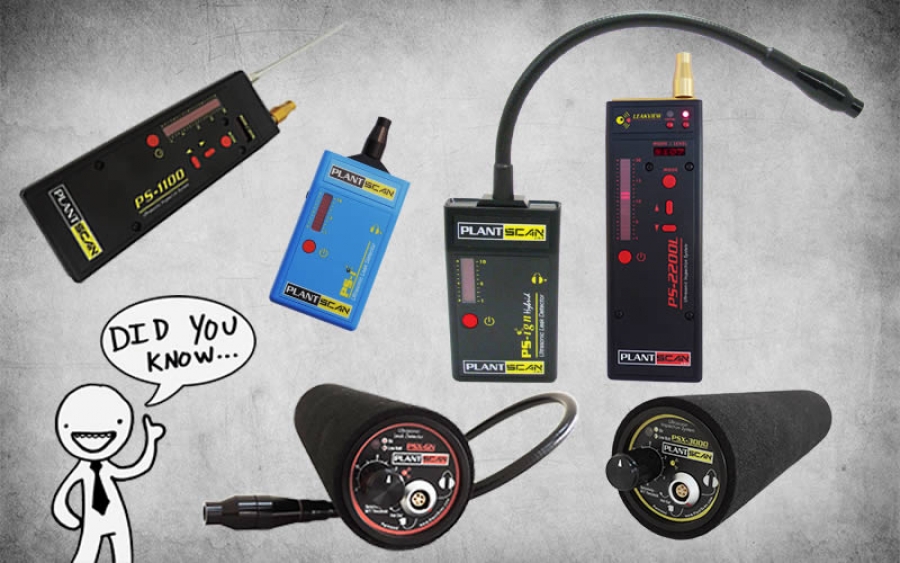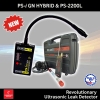Absolutely yes. Is the best solution for HVAC area.
Can it detect all refrigerants? Old and New?
Yes, both old and new.
Can it detect Nitrogen?
Yes.
Can it detect CO2?
Yes.
Can it detect Ammonia?
Yes, however you must be very careful around ammonia refrigeration systems since ammonia is asphyxiating. It will not detect a leaked concentration in a room which can cause DEATH!
How can it detect all these gasses?
The detector is detecting sound not a chemical property of the leaked gas. It does not matter what the gas is as long as it is flowing.
Common freon gases: R134A, R410A, R600A, R22, R404A, R407C, R22R, R22M, R407A, R410A, R417a (ΜΟ59), R22L, R422D (MO29), R413A (MO49), R422A (MO79), R507, R1234yf
Is it affected by “high” concentrations of refrigerants like in basements and in coolers?
No, since it does not detect a chemical in air it does not matter how much refrigerant is in air.
Is it affected by wind on a roof top?
No, ultrasound travels at the same speed in calm or windy air and it travels much faster than any wind speed on the planet. The speed of sound is 767 mph or 1,234km/h
Can I find vacuum leaks?
Yes. Air sucked into a system from a leak point will generate ultrasound just like when it leaks under pressure out of the system. The Ultrasonic Leak Detector is the only technology which can detect vacuum leaks from the outside of the system and pinpoint the leak point.
How far can I find a leak?
Depending on leak size, shape and system pressure 10-to-40 feet.
How easy is it to locate a leak from distance?
It is very easy to find where the leak is since ultrasound is very directional, it is a sound microwave. It moves in straight lines and does not bend like our voice around objects. Tracing it will take you to the leak.
How fast can I find a leak?
Leaks can be located very fast, at the speed of sound! You do not need to move slowly around suspected points like you do with sniffers of any kind.
Is it affected by other sounds in the area?
Not to sounds we hear, but there is a lot of ultrasound around us that we do not know it is there since we cannot hear it. Examples are switching power supplies, variable speed drives (VFD), computer monitors and many other sources.
However our patented heterodyned technology will allow you to distinguish between leaks and mechanical sounds simultaneously so you can distinguish which is the leak.
How do I find internal leaks?
Restrictions in pipe systems or leaks though valves generate ultrasound. Touching the valve with our patented Resonator Touch Probe (R-Probe) will transfer the leak sound to the PS-i which will indicate the leak.
Can I detect problems in Thermal Expansion Valves (TXVs)?
You can detect in 10 minutes a faulty TXV where it will take you an hour with the usual (superheat) techniques.
Can I use ultrasonic leak detection techniques on other valves?
Yes, any kind of valve.
Steam traps are automatic purging valves, how can I inspect them?
Using the touch probe (any model), you touch the valve and hear if the steam trap is cycling, stuck open, or closed. Please visit www.PlantScan.com and download a step-by-step guide on how to check steam traps.
Should I inspect all steam traps in a system?
Yes. Each leaky trap can waste from hundreds to thousands of dollars in energy costs per year. EPRI (an energy institute in the USA) estimates that in facilities using steam at any moment 20-30% of the traps leak.
Can I detect condensate in a pipe?
We have the only ultrasonic leak detectors on the market the PS-2100 and the PS-2200L that can detect at the push of a button sonic sound which is the sound condensate makes as it flows in a pipe.
What is the SoundBurster?
The SoundBurster is an ultrasound generator that helps you find leaks when you cannot pressurize a space like a room, a walk-in cooler, a display case a tank etc.
How is the SoundBurster (SB) used?
You place the SB in the cooler, room or tank you want to test for (air) leaks and turn it on. You go to the outside, close the door and using the PS-i or any other PlantScan® model you search for sound escaping from cracks or other problems in gaskets or seals.
Can I find water leaks in windshields?
Yes! You place the SB in the vehicle, close the doors and windows and search with an ultrasonic leak detector from the outside around the seals. The user manual of the PS-i has an extensive section on this application. Similarly you can find leaks in trunk seals or any other enclosures that need to be leak free such as tanks, truck trailers (refrigerated or normal) even the hatches on bulk carrier ships.
Can I “pipe” the SB in a pipe and check for leaks?
No, Sound does not travel well in pipes and especially ultrasound which gets attenuated in long runs and in bends,
Can I check heat exchangers in heaters with the SB and the ultrasonic leak detector?
No, the SB will vibrate the thin sheet metal of the exchanger and give false positives.
Can I find leaks in pipes inside walls?
It depends on the situation and the size of leak. If the leak makes a lot of sound (it is large) and the pipe is not covered by thick insulation yes, however some times it is necessary to leak test these portions at 500psi with nitrogen and to use the touch probe poking holes in the wall.
Can I find leaks in insulated pipes from compressor rooms to coolers & freezers from a distance?
Generally, no! Some times it is necessary to leak test these portions at 500psi with nitrogen and cut a small slit on the jacket to insert a piece of ¼” tubing, the waveguide, to check between the wall of the pipe and the insulation.
Can I find leaks underground?
Usually, No. If the pressure is very high it is possible using the touch probe and a metal rod nailed in the ground to locate the general vicinity which may be enough.
Can I find leaks in overhead lines?
Yes. The Ultrasonic Leak Detector is the only detector that can locate a leak independent of gas from distance.
I hear you can find mechanical and electrical problems with these instruments, what can you tell me about that?
Friction generates ultrasound. This ultrasound propagates through a machine and can be detected at various points. The stronger point is where it is generated and it is usually in bearings. Similarly arcing inside relays and contactors make ultrasound even if they seem “normal” This sound sometimes sounds like frying potatoes.
Can I tell if a bearing is going bad?
Yes. Depending on the PlantScan® model you have, you can even use AudioZoomTM (found in the PS-1100, PS-2100 & PS-2200L) to detect small problems in their beginning.
Can I tell if a bearing needs grease and how much?
Yes. Until now lubricating a bearing was a hit or miss task. Now you can hear the sound of a bearing before you grease it, during (you can even hear the grease entering) and after so you know exactly when to stop.
What types of electrical problems can you find?
The most common problem is arcing. Arcing occurs in switches, contactors and relays when the contacts wear out. Arcing makes a sound like frying. Arcing is a phenomenon that can take place at any voltage, high or low.
Are there other electrical problems that can be detected?
Yes, Corona. Corona happens around high voltage insulators. Eventually it will turn into an arc with catastrophic results. This happens in high voltage transformers and distribution networks.
Ok, but I do not work with kilovolt circuits, what other electrical problems that can I find?
“Strange” sounds around motors, generators, power supplies and VFD. Most switching power supplies use high frequency transformers which exhibit a phenomenon called magnetostriction. This phenomenon causes the core of the transformer to constrict when the magnetic field around it rises very fast in a pulse like manner. This should sound like a high pitch tone, however if it is exhibiting crackling noises the core is either damaged or loose.
Similarly rotating electrical machinery should sound smooth and free from sparks and other transient noises.
Your PlantScan® Ultrasonic leak detector will teach you which of these sounds are normal and which are not.
Read some more information about "How to select a leak detector".
If you want to post the above content on any other website please include a link to www.plantscan.eu


 ES
ES
 DE
DE
 PL
PL




